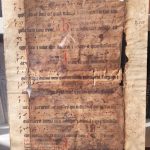The fragment was given to Janka Szendrei by Magdolna M. Gregoria Forrai SSND, and transferred after Szendrei’s death to the Library of the Church Music Department of the Liszt Ferenc Academy of Music in Budapest. Janka Szendrei assumed, the fragment – numbered as F 337 in her catalog published in 1981 (see Bibliography) – was written in the 14th century, and based on its notation she suggested te fragments Transylvanian provenance. The neumes used on the fragment, their special combination, the four red stave lines, the absence of custos (the custodes at the end of the lines were added later) all imply Hungarian provenance. Szendrei, in her basic work on the history of Hungarian music notation (published 1983, see Bibliography), gives further analysis of this notation. She highlights the unique form of the climacus with a lain virga (virga iacens), which she picturesquely describes as a climacus with a „hat”, which appears in early notations – among them on this fragment – as a separate form. In later cursive notations, this peculiar horizontal character seems to be the fusion of two puncta which start the climacus of the Hungarian (Esztergom) notation. (Cf. the 17th-century cursive plainchant notation of the renowned Franciscan church musician, Joannes Kájoni, in which the two puncta at the beginning of the climacus also fuse into an undulate line.) Szendrei suggest that the notation of the fragment, which forms an integral system, is the creation of a yet unknown workshop in Transylvania, or in a broader view, in the eastern region of medieval Hungary. Gabriella Gilányi verifies in her monograph Mosaics of the plainchant tradition of Transylvania (2019, see Bibliography) – based on an even broader range of sources – that the peculiar climacus of the fragment is part of the notation tradition of Transylvania, since it is traceable on several 14–15th century Transylvanian fragments.
In contrary, a notation by a later (15–16th century?) hand is visible on the verso of the fragment, at the bottom margin, which does not represent the aforementioned Transylvanian features. For example, it shows a climacus with the widespread double puncta. This does not contradict what had been said about the main notation of the fragment, it rather suggests, that among the late-medieval Transylvanian singers and notators there were people with different erudition.
The liturgical investigation also makes the Hungarian provenance of the fragment indubitable, hence the Burial of King Saint Ladislaus (Depositio Sancti Ladislai regis, 29th July) appears among the feasts of the Sanctorale (from 22nd June to 6th August). The recto is entirely notated with the chants of the Office of Mary Magdalene. The hymn of the lauds, Fundans Sion (AH 45a,8) is seldom documented in the Hungarian tradition. Among the musical sources it can only be found in the rubrics of an antiphonal of Pozsony/Bratislava (Bratislava, Štátny archív, EC Lad. 3, see http://cantus.sk/source/14828) and in a few Esztergom breviaries (Zagreb, Metropolitanska knjižnica MR 67; Alba Iulia, Biblioteca Batthyaneum, R. I. 110; Wien, Österreichische Nationalbibliothek, Vindob. Pal. 1829, all included in Andrea Kovács (ed.), Corpus Antiphonalium Officii Ecclesiarum Centralis Europae V/B, Esztergom / Strigonium (Sanctorale), HAS Institute for Musicology, Budapest, 2006, 137–138), while it is missing from the Transylvanian liturgical sources (see Andrea Kovács, ed., Corpus Antiphonalium Officii Ecclesiarum Centralis Europae VII/B Transylvania-Várad (Sanctorale), HAS Institute for Musicology – Liszt Ferenc Academy of Music Research Group for Church Music, Budapest, 2010). The hymn (!) Dic nobis Maria, assigned to the 2nd Vespers, cites a line from the Easter sequence Victimae paschali laudes evoking an imaginary dialog between Mary Magdalene and the disciples. Neither domestic nor foreign traditions document this chant in this particular function. Otherwise, the order of chants in the Office of Mary Magdalene is closer to the Esztergom use than to the Transylvanian.
The antiphon Sancte Ladizlae in the 1st Vespers deserves attention among the rubrics of the verso, as it is unknown from the offices of Saint Ladislaus. By all odds, it is not a hitherto unknown antiphon, but an adaptation identified in a 15th-century breviary from Bártfa/Bardejov (Budapest, Hungarian National Museum, 63.74.I.C): the common antiphon of the confessors, Sancte N. confessor Dei was actualized with the name of Saint Ladislaus (see Andrea Kovács, ed., CAO-ECE V/B, 130; cf. Andrea Kovács, „Vergente mundi vespere. Egy ismeretlen Szent László-himnusz a Szepességben és Sittenben” [An unknown hymn to St. Ladislaus in the Szepes region and in Sitten], Magyar Könyvszemle 134 (2018/2): 131).
As László Dobszay pointed out, it is unusual in the Transylvanian tradition incorporate common chants in the Office of Saint James. The Office of Saint Anna was most likely written in the appendix of the manuscript, as the rubric refers to it with the phrase „invenies infra”. Dobszay also observed that the scribe copied to the feast of Inventio Stephani (3rd Aug) the chants of his other feast (26th Dec), that means, he was not familiar with the proper historia Luciano venerabili; the order of responsories in the matins is irregular too. The third responsory’s text (Videbant omnes Stephanum) also starts unusually, using a different past time (Viderunt omnes Stephanum), which is yet unprecedented either in Hungarian or in foreign traditions.
While the melodic variants of the fragment show connection with the melodies of Esztergom sources, it is apparent, that they belong to a different tradition. The unusual liturgical assignments and the notation both suggest the fragment being a source of a characteristic Hungarian sub-tradition, which can not be defined more exactly than Transylvanian.
Gábriel Szoliva



